Sugar-preserved fruits can stay fresh for up to 18-24 months when you store them properly. You'll get the best flavor in the first year at room temperature, while refrigerated preserves can last up to 2 years with better texture retention. If you're freezing your preserved fruits, they'll keep for over 2 years, though texture might change slightly. Commercial products typically last longer than homemade versions due to professional packaging and preservatives. For ideal freshness, store your preserves in airtight containers at 0°F (-18°C) or below, and check regularly for signs of spoilage. Understanding proper storage techniques and container choices can greatly extend your preserves' shelf life.
Understanding Sugar Preservation Methods
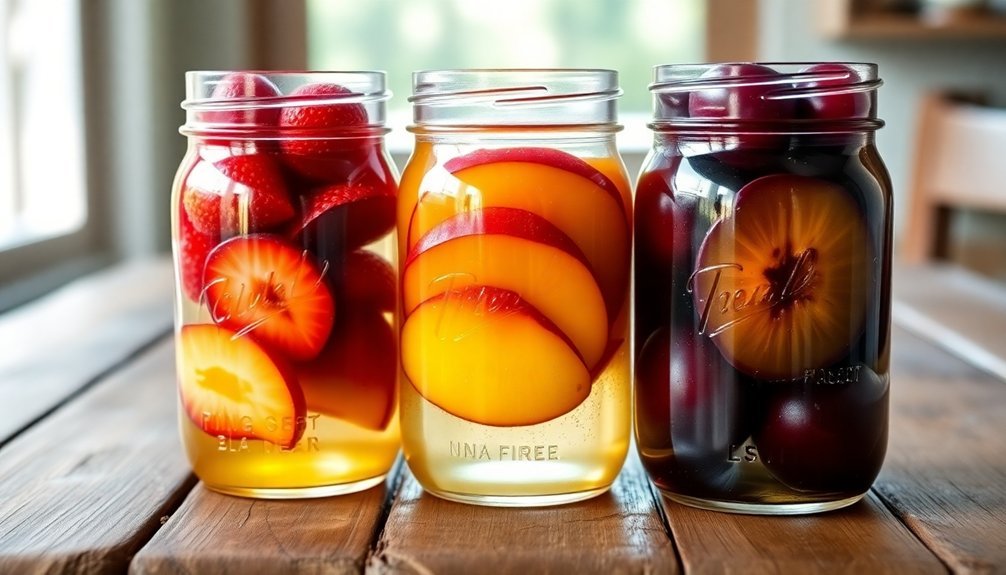
You can adjust sugar concentrations based on your fruit's natural sweetness.
Traditional preservation techniques have been used for centuries to keep fruits edible year-round.
For most preservation methods, you'll want to use a ratio of about 60% fruit to 40% sugar, though equal ratios are sometimes necessary.
Each method offers distinct advantages – syrup works best for whole fruits, dry pack for cut pieces, and sugar freezing for delicate berries.
Optimal Storage Conditions
After selecting your preferred preservation method, proper storage becomes the next key step in maintaining fruit quality.
You'll need to pay careful attention to temperature and humidity levels to guarantee your sugar-preserved fruits maintain their taste and texture for the longest possible time.
For best results, store your preserved fruits at 0°F (-18°C) or below, which can keep them fresh for 8 to 12 months. You'll want to use airtight, moisture-proof containers, preferably glass ones that let you monitor any moisture buildup. Improper storage conditions can lead to losses of 10-40% in preserved fruits.
Keep your preserved fruits away from strong-smelling foods, as they can absorb unwanted odors.
Here's what you need to maintain proper storage conditions:
- Temperature control – Keep sugar-preserved fruits frozen at 0°F or below for long-term storage
- Humidity management – Store in airtight containers to prevent moisture absorption
- Dark environment – Place containers in a cool, dark area to maintain quality
- Regular monitoring – Check for condensation and proper sealing weekly
If you're storing fresh fruits before preservation, maintain temperatures between 32°F to 36°F (0°C to 2°C) with 90-95% humidity to prevent shriveling.
Remember to label your containers with dates to track storage duration.
Container and Packaging Choices
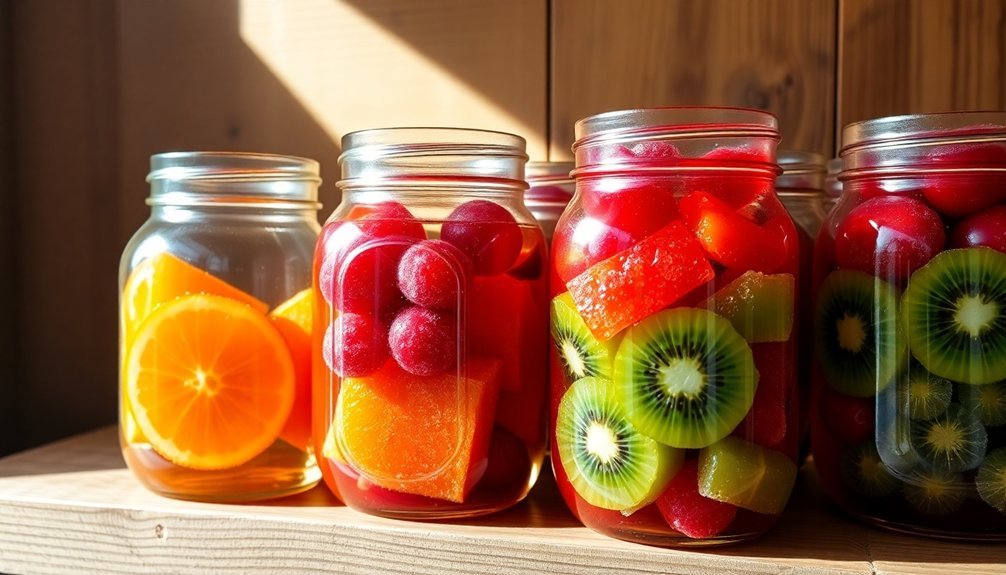
For successful fruit preservation, selecting the right container and packaging is essential to maintaining freshness and quality. You'll want to choose containers that match your preservation method, whether you're using sugar packs, syrups, or vacuum sealing.
| Container Type | Best For | Key Benefits |
|---|---|---|
| Glass Jars | Sugar/Syrup Packs | Airtight seals, visible contents |
| Rigid Plastic | Freezing | Prevents freezer burn, stackable |
| Metal Cans | Long-term Storage | Blocks light and moisture |
| Freezer Bags | Flexible Storage | Space-saving, moisture-resistant |
When you're working with sugar-preserved fruits, you'll need containers that can handle sugar mixtures without leaking. Glass jars with tight-fitting lids are ideal for sugar packs, while rigid plastic containers work well for frozen preservation. For vacuum-sealed products, you'll want to use specialized bags that can maintain an airtight environment. Nitrogen flushing can be used to remove oxygen from containers before sealing, which helps prevent spoilage.
Don't forget to label your containers with the date and contents. You should also implement a first-in-first-out system to manage your preserved fruit inventory effectively. Check your containers regularly for signs of moisture or damage that could compromise the fruit's quality.
Sugar Syrup Science
You'll find sugar's preservation power lies in its remarkable ability to draw moisture from foods through osmosis, creating an environment where harmful bacteria can't thrive.
When you're making preserves, the syrup concentration directly affects how well your fruits will keep, with higher sugar content offering better preservation but potentially masking natural fruit flavors.
Different syrup concentrations work best for different fruits, so you'll need to adjust your sugar-to-water ratio based on both the fruit type and your desired preservation timeline.
Sugar's Preservation Power
Sugar's remarkable preservation power lies in its ability to protect and extend the life of fruits through multiple scientific mechanisms. When you add sugar to fruits, it creates an inhospitable environment for harmful bacteria by reducing water activity through osmosis. This process pulls moisture away from microorganisms, preventing them from multiplying and causing spoilage.
You'll find that sugar doesn't just preserve – it also enhances your fruits by maintaining their texture, color, and flavor. In frozen preparations, sugar helps prevent damage from ice crystals, while in canned fruits, it creates a protective syrup that guards against quality loss.
- Your sugar-preserved fruits can last 6-12 months when stored properly
- You'll get better texture retention compared to using artificial sweeteners
- Your fruits remain protected from harmful bacteria like Salmonella
- You'll see improved color and flavor preservation throughout storage
Sugar's preservation power extends even further through fermentation, where it can be converted into natural preservatives like alcohol and organic acids.
When you store sugar-preserved fruits in cool, dry, and dark conditions, you're maximizing their shelf life while maintaining ideal quality.
Syrup Concentration Effects
Understanding syrup concentration is essential for successful fruit preservation. When you create a sugar syrup solution around 60%, you'll effectively reduce the water activity in your preserved fruits, making it difficult for bacteria, yeasts, and molds to survive. The maximum concentration of saccharose you can achieve in the liquid phase is about 67.89%, though total sugar content can be higher due to saccharose inversion.
You'll need to adjust your syrup concentration based on your preservation goals. For medium syrup, dissolve 1¾ cups sugar in 4 cups of water, using ½ to ⅔ cup syrup per pint of fruit. Higher sugar concentrations will give you better texture retention and color preservation, while also extending shelf life.
When you're freezing fruits, the syrup helps prevent ice crystal damage by lowering the freezing point. You can enhance your preservation results by adding pectin to the syrup, which improves texture in fruits like peaches and strawberries.
The syrup's hygroscopic properties will help absorb excess moisture, further protecting your preserved fruits from spoilage. Remember that proper syrup concentration isn't just about sweetness—it's vital for maintaining your fruits' quality and ensuring long-term preservation success.
Temperature and Humidity Control
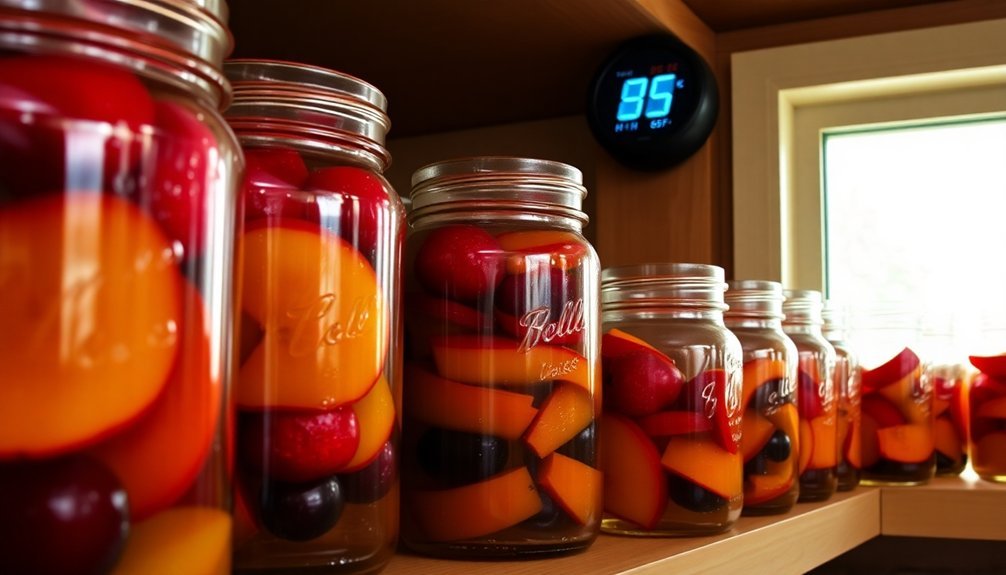
Maintaining precise temperature and humidity control plays a critical role in preserving sugar-treated fruits. You'll need to monitor both factors carefully throughout the preservation process, from initial preparation to long-term storage, to guarantee your fruits stay fresh and safe to eat.
For ideal preservation, you'll want to process your jars in a boiling water bath at temperatures between 217-222°F (103-106°C). This range guarantees proper sterilization while achieving the right sugar concentration for preservation.
Once processed, store your preserved fruits in a cool, dry place with good air circulation to prevent moisture buildup and mold growth.
- Keep storage temperatures at 0°F (-18°C) or below for frozen preserved fruits
- Maintain humidity levels low enough to prevent moisture reabsorption in dried fruits
- Store preserved jars at room temperature in a dark, dry location
- Monitor storage conditions regularly to catch any changes in temperature or humidity
Remember that proper packaging is essential – use moisture-proof containers and guarantee tight seals to maintain the preservation environment you've created.
This combination of temperature and humidity control will help prevent microbial growth, slow enzymatic degradation, and extend your preserved fruits' shelf life considerably.
Shelf Life Duration
When properly prepared and stored, sugar-preserved fruits can maintain their quality for an impressive period of 18-24 months. You'll find that commercial products typically last longer than homemade versions due to standardized processing methods and controlled environments.
| Storage Method | Expected Shelf Life | Quality Notes |
|---|---|---|
| Room Temperature | 18-24 months | Best flavor first year |
| Refrigerated | Up to 2 years | Maintains texture better |
| Frozen | 2+ years | Slight texture changes |
| Homemade | 6-12 months | Monitor regularly |
You'll need to pay attention to storage conditions to achieve maximum shelf life. Keep your preserved fruits in airtight containers, away from heat sources and strong odors. While the high sugar content helps prevent spoilage by creating an inhospitable environment for microorganisms, you should still check your preserved fruits regularly for any signs of deterioration.
Remember that even though your preserved fruits might still be safe to eat after their recommended shelf life, their flavor and texture may begin to change after the first year. You can extend their peak quality period by storing them in the refrigerator or freezer, especially if you live in a warm climate.
Signs of Fruit Spoilage
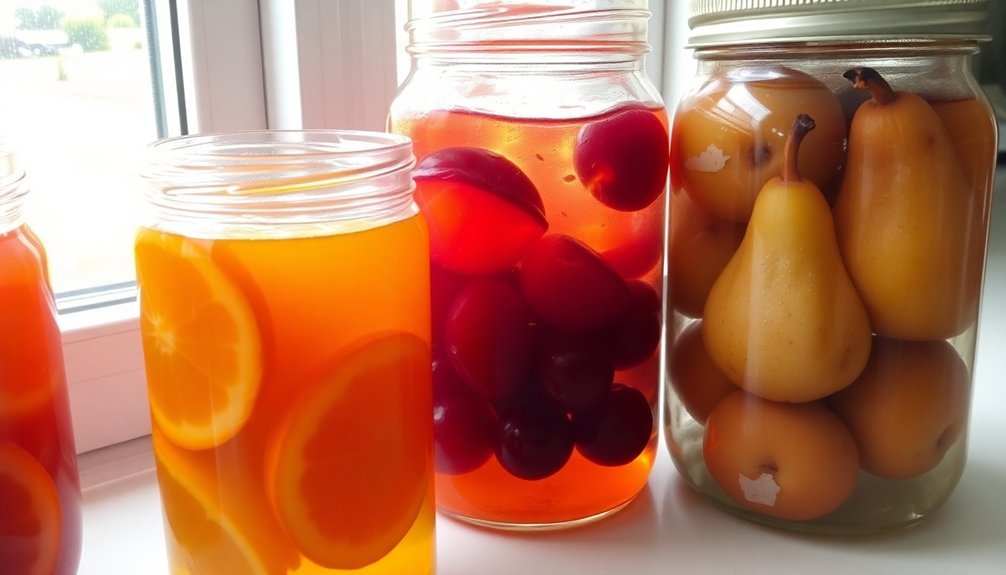
To protect your sugar-preserved fruits, you'll need to check for common visual warning signs of spoilage, including discoloration, mold growth, and unusual texture changes.
You should examine the fruit's surface for any brown spots, grey patches, or fuzzy mold formations that indicate microbial contamination.
If you notice shriveling, softening, or a slimy coating on your preserved fruits, these physical changes signal that the fruit is no longer safe to consume.
Visual Warning Signals
Throughout the storage life of sugar-preserved fruits, you'll need to watch for several key visual warning signals that indicate spoilage. If you spot any of these signs, it's best to discard the affected fruit to prevent any health risks and guarantee food safety.
1. Mold and Fungal Growth: Look for white, green, or black patches on the fruit's surface. You'll notice a slimy or powdery texture, often accompanied by a musty smell.
Don't attempt to salvage moldy fruit, as the spores can be resistant to sugar preservation.
2. Color Changes: Watch for unnatural darkening or fading of the fruit's natural color. If you notice uneven color distribution or significant dulling, the fruit may be deteriorating due to oxidation or light exposure.
3. Texture Abnormalities: Check for soft, mushy areas or overly dried portions. If your preserved fruit feels soggy or shows unusual sticky residues, it's likely compromised.
4. Odor and Flavor Changes: Trust your senses if you detect sour or fermented smells. Even properly stored fruits can develop off-flavors after a year, so pay attention to any bitter or uncharacteristic tastes during regular quality checks.
Physical Changes To Watch
Sharp-eyed monitoring of physical changes remains critical for detecting fruit spoilage in sugar-preserved products.
You'll need to watch for signs of water loss, which typically manifests as shriveling, wilting, or obvious shrinkage in the preserved fruit. When water loss exceeds 3-10%, depending on the fruit type, you're likely to notice significant changes in texture and firmness.
Watch for mechanical damage like breaks, cracks, or bruising in the fruit's surface. These injuries accelerate deterioration by increasing respiration rates and creating entry points for microbes.
You'll often see cellular leakage around damaged areas, which can lead to rapid spoilage. Pay attention to changes in the fruit's internal composition – any unusual softening, discoloration, or texture changes can indicate ongoing degradation of nutrients and cellular structures.
Monitor how the fruit's metabolic processes are affecting its quality. If you notice accelerated changes in sugar content, firmness, or aroma, it's likely due to increased respiration rates breaking down complex sugars.
The presence of carbon dioxide buildup or excessive moisture in the storage container can also signal that preservation conditions aren't ideal and spoilage may be imminent.
Extending Storage Life
Successfully extending the storage life of sugar-preserved fruits depends on proper storage conditions and handling techniques.
You'll get the best results by maintaining temperatures between 60-70°F in a dry, dark environment away from strong odors and temperature fluctuations. The sugar syrup's high concentration serves as a natural preservative, creating an environment where microorganisms can't thrive.
- Store your preserved fruits in airtight containers, placing waxed paper between layers for easy removal and better preservation.
- Keep them in a cool pantry or cabinet away from appliances like stoves and dishwashers that generate heat and moisture.
- Transfer to the refrigerator in sealed containers for storage up to one year.
- Freeze in appropriate containers or bags for up to two years of preservation.
You can maximize shelf life by regularly inspecting your preserved fruits for signs of spoilage and maintaining proper sugar coating.
If you notice any moisture absorption, simply re-pack the fruit in sugar. Remember to rotate your stock, using the oldest preserved fruits first to maintain freshness throughout your collection.
For frozen fruits, always thaw them in the refrigerator before use to maintain their quality.
Preserving Different Fruit Types
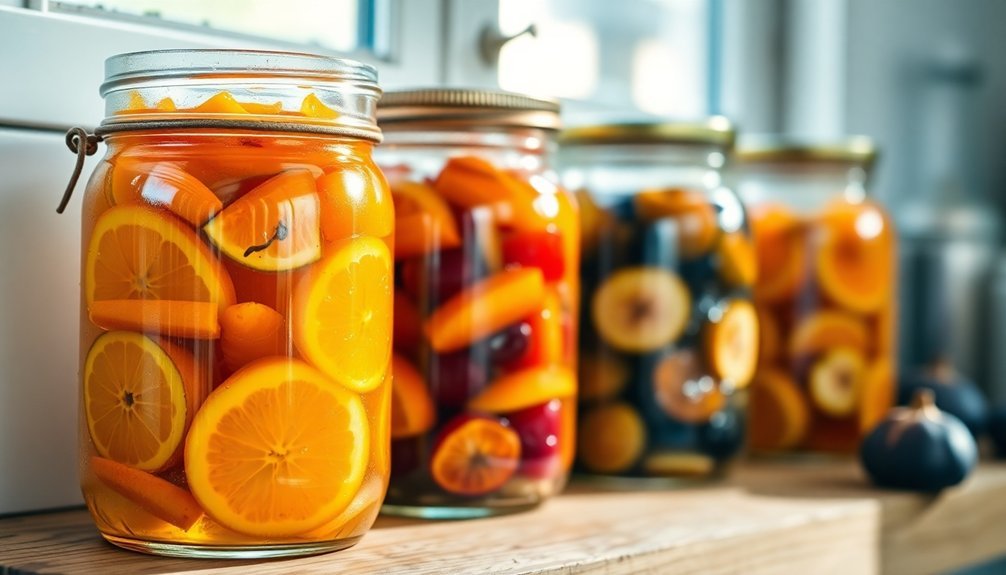
Different fruits require specific preservation approaches to maintain their ideal quality and shelf life. When you're selecting fruits for preservation, choose fully ripe specimens that are fresh and free from defects, as these will give you the best results regarding flavor and texture.
You'll find that strawberries and peaches benefit from pectin syrup to maintain their structure, while citrus fruits have their own unique preservation requirements. The sugar concentration you use is vital – it's not just about sweetness but creating an environment where microorganisms can't thrive.
If you're thinking about using sugar substitutes, be aware that they won't provide the same preservative benefits and could affect both nutritional value and shelf life.
To preserve your fruits effectively, you'll need to control moisture levels carefully. Pack them in syrup or sugar to maintain low moisture content, as high humidity can lead to rapid spoilage.
When storing your preserved fruits, keep them in airtight containers or freezer-safe bags at temperatures between 60-70°F (15-21°C). For extended storage, you can refrigerate or freeze them – freezing particularly helps maintain quality for up to two years.
Commercial Versus Homemade Storage
The storage requirements for commercial and homemade sugar-preserved fruits share some common ground, but you'll notice distinct differences in their packaging and shelf life.
Commercial products typically last up to two years when stored properly, while homemade versions usually maintain their quality for 6-12 months. Both types require cool, dry storage conditions between 60-70°F (15-21°C) and benefit from airtight containers.
- Commercial products come with professional packaging that's specially designed to maintain freshness, often including moisture barriers and protective seals.
- Homemade preserves require careful attention to packaging – you'll need to use proper airtight containers and separate layers with waxed paper.
- Commercial products usually include "best by" dates spanning 18-24 months, giving you a clear timeline for consumption.
- Homemade versions need more frequent monitoring for quality, though they can last up to two years with ideal storage.
Both types require regular inspection for signs of spoilage, including mold, yeast growth, or off-odors.
You'll want to pay special attention to homemade preserves, checking them more frequently since they lack commercial preservatives and professional packaging.
Monitoring and Maintenance Tips
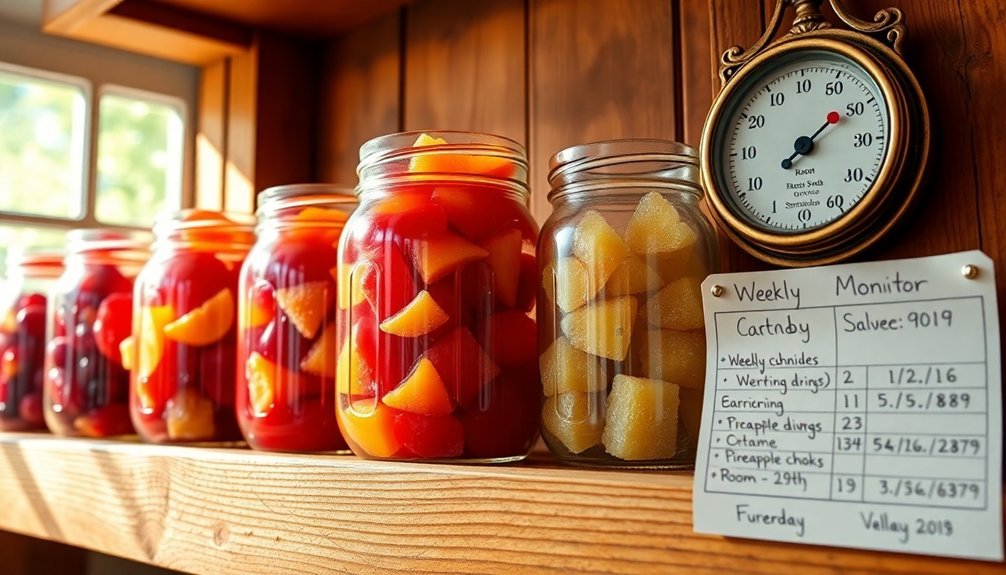
Maintaining sugar-preserved fruits requires regular monitoring and specific upkeep practices to assure ideal quality.
You'll need to store your preserves in a cool, dark location away from direct sunlight to prevent degradation and maintain their vibrant colors and flavors. Make sure your storage area isn't humid and remains odor-free, as sugar can absorb strong smells.
Check your jars' seals regularly to guarantee they're intact and airtight. You should use sealed containers with tight-fitting lids, and consider adding an extra layer of protection with parchment paper or cling film.
If you've opened a jar, store it in the refrigerator to extend its shelf life.
Monitor your preserves' consistency and texture periodically. They should be set but slightly runny, and you can use the freezer test to verify the proper consistency.
Watch for any signs of spoilage, such as mold, unusual odors, or changes in color and texture. When properly sealed and stored, your preserves can last at least a year, but you'll want to inspect them regularly for any leakage or seal failure.
Always use sterilized jars and utensils to prevent contamination.
Frequently Asked Questions
Can Sugar-Preserved Fruits Be Safely Consumed After Their "Best By" Date?
Yes, you can safely eat sugar-preserved fruits months after their "best by" date if they're properly stored. The high sugar content prevents bacterial growth, but you'll want to check for mold or dampness first.
Are Sugar-Preserved Fruits Safe for Diabetics to Eat in Moderation?
While you can eat sugar-preserved fruits as a diabetic, you'll need to carefully monitor your portions and blood sugar levels. It's best to consult your healthcare provider about incorporating them into your diet.
What Happens if I Accidentally Freeze and Thaw Sugar-Preserved Fruits Multiple Times?
If you repeatedly freeze and thaw sugar-preserved fruits, you'll notice they become increasingly mushy and watery. Each cycle damages cell walls further, affecting texture and potentially increasing bacterial growth risk. Avoid multiple thaw cycles.
Can Pets Safely Consume Sugar-Preserved Fruits as Occasional Treats?
You shouldn't feed sugar-preserved fruits to your pets. While they're not toxic, they can cause digestive issues, obesity, and diabetes. Instead, offer fresh, pet-safe fruits as occasional treats after consulting your veterinarian.
How Do Different Sugar Types Affect the Nutritional Value of Preserved Fruits?
Different sugars affect your preserved fruits' nutrition uniquely. While granulated sugar adds calories without nutrients, natural sweeteners like honey offer trace minerals. All sugar types will increase the carbohydrate content of your fruit.
In Summary
You'll get the best results from your sugar-preserved fruits by storing them in airtight containers at cool temperatures between 50-70°F. When properly prepared and maintained, they'll typically last 6-12 months. Remember to check periodically for signs of fermentation or mold. By following proper preservation techniques and storage guidelines, you can enjoy your preserved fruits throughout the year while maintaining their flavor and quality.





Leave a Reply